#cambaridae
Text

Chatooga River Crayfish (Cambarus scottii), family Cambaridae, found along the east coast of Canada and the U.S.
photograph by Guenter Schuster, Eastern Kentucky University
1K notes
·
View notes
Text
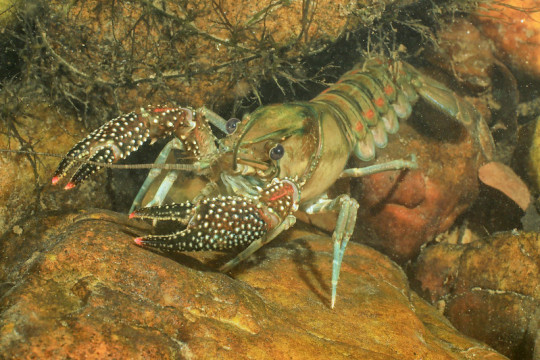
A crayfish (Procambarus spiculifer) in Ellijay River, Georgia, USA
by Alan Cressler
#crayfish#crustaceans#procambarus spiculifer#procambarus#Cambaridae#decapoda#Malacostraca#arthropoda#wildlife: georgia#wildlife: usa#wildlife: north america
351 notes
·
View notes
Text
Uncharismatic Fact of the Day
Chemical cues are an important part of communication for many animals, but the rusty crayfish takes it in an unusual direction. When individuals encounter each other, they use odors from urine to determine how to react. The stronger the cue, the less aggressive they are during the ensuing fight. A victorious male will also recognize the urine of a previously defeated opponent and will display dominance before attacking.

(Image: A rusty crayfish (Faxonius rusticus) by Peter Chen via Wikipedia)
If you like what I do, consider leaving a tip or buying me a ko-fi!
#rusty crayfish#Decapoda#Cambaridae#freshwater crayfish#crayfish#decapods#arthropods#uncharismatic facts
69 notes
·
View notes
Text
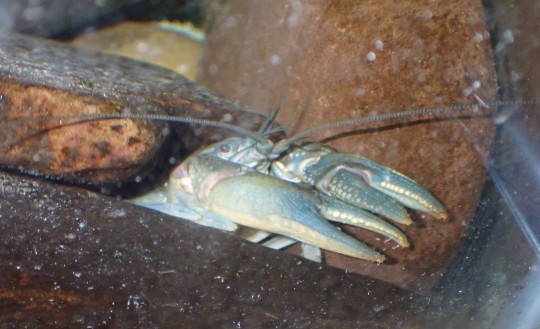
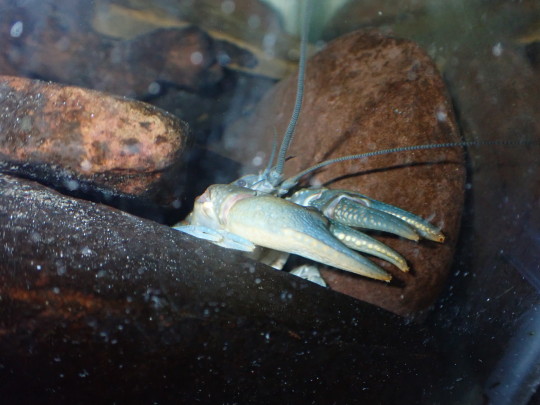
My pet crayfish (her name is Crime) has started hanging out between these rocks everyday.
2 notes
·
View notes
Text
Utrecht council and water company Waternet have called in aquatic ecologists to combat the rise of American crayfish in a new experiment using plants, predatory fish and AI.
The crayfish – Procambarus clarkii, or red swamp crayfish – are thought to have travelled from their native United States in the ballast tanks of large freighters and are well adapted to local waterways. They are particularly common in Utrecht, Noord-Holland and Zuid-Holland.
First spotted in Dutch waters in 1985 and largely without any natural enemies, crayfish numbers are now thought to be running into billions. Their presence is said to be a threat to water flora and fauna and they also damage to river banks.
In the Molenpolder near Maarssen the crayfish have demolished practically all plant and animal life, aquatic ecologist Winnie Rip told the Telegraaf. “They are opportunists. If one species runs out the turn to the next. They muddy the water which causes a decline in plants and animals and, ultimately, biodiversity.
continue reading
#netherlands#invasive species#american crayfish#decapoda#cambaridae#procambarus clarkii#biological controls#catfish#bladderwort#ai
0 notes
Video
Defense posture - Red Swamp Crayfish by Georgie Alexon
Via Flickr:
As we were driving down an estuary road in Portugal we stopped to avoid this crayfish. When we got out of the car to wait he stood up in this posture. In Portugal there was only one European crayfish species, the white clawed Austropotamobius pallipes. During the last decade they have become mostly extinct and overtaken by the invasive species of Red swamp crayfish. Also known as Louisiana crawfish or mudbug. -Procambarus clarkii
#Procambarus clarkii#Cambaridae#red#crayfish#wildlife#nature#photography#canon#Portugal#outdoors#crustacean#animal#defense#colors#europe#flickr
1 note
·
View note
Photo
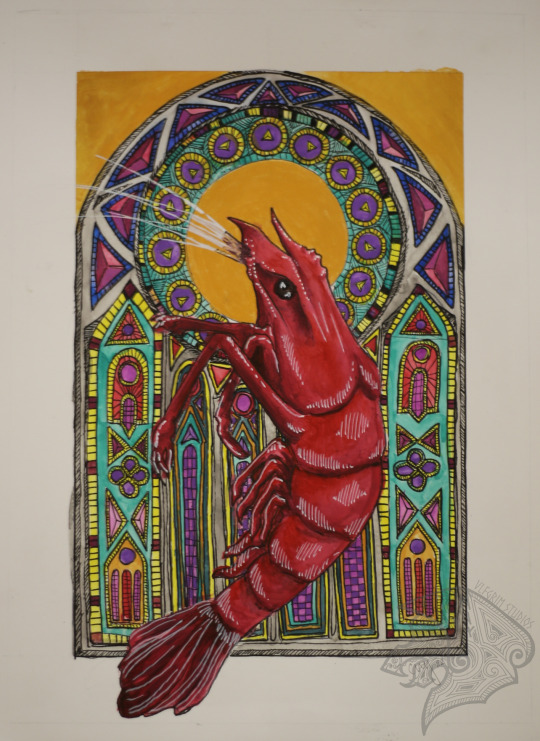


“The Holy Trinity of the Bayou: St. Caridea, St. Lagarto and St. Cambaridae”
-C. McLean, 2022 watercolor, ink, acrylic on Bristol
IG: vlfgrimcreatives
#illustration#illustration painting#louisiana#bayou#cajun#watercolor#shrimp#shrimp art#alligator#alligator art#crawfish
36 notes
·
View notes
Text
Melanized Lesions in Red Swamp Crayfish (Procambarus clarkii) Reared in the Laboratory Conditions
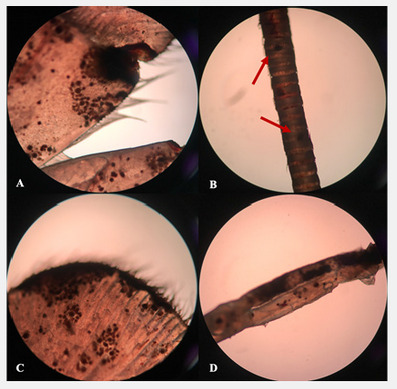
Authored by: Onur Karadal
Abstract
Red swamp crayfish (Procambarus clarkii) is an economic decapod species and the most cultivated crayfish in the world. In nature, this species can tolerate the hardy alterations, but they are vulnerable to water parameters in culture conditions. Crayfish have to molt to grow, and the non-renewable shell is a suitable surface for pathogenic activities until the next molt. In this study, melanized lesions were determined in red swamp crayfish from several parts of body exoskeleton: cephalothorax, abdominal shell, uropods, walking legs, swimmerets, and antennae. The bacteriological and mycological isolations were conducted onto tryptic soy agar, brain heart infusion agar, Sabouraud’s dextrose agar and glucose yeast agar, but no particular microbial growth was observed from cultured samples. The aetiology of the case was not associated with any bacterial or fungal agents; however, the water conditions could be related with the melanosis.
Keywords: Cambaridae; Molting; Shell rot; Exoskeleton erosion; Appendages
Introduction
Red swamp crayfish (Procambarus clarkii) is native from north-eastern Mexico and United States (Louisiana). The species is resistant to extreme conditions, including oxygen and temperature alterations, water pollution, and drought and located in wetlands, marshes, rivers, and lakes [1,2]. However, this crayfish is the most cultivated species in the world and has an economic importance for both aquaculture and aquarium sectors [3]. Besides the popularity of this species, invasive effects have been recorded from North and South America, Europe, Asia, and Africa [4]. In Turkey, no commercial red swamp crayfish cultivation has been done. This species accepted as a pet in the last quarter of the 2000s and traded as the most common crayfish species in the aquarium industry of Turkey. Red swamp crayfish is a member of Order Decapoda (Crustacea), which characterized by ten jointed legs and other appendages. Five pairs of pereiopods (walking legs) and pleopods (swimming legs) exist beneath their cephalothorax and abdomen regions [5]. Segmented antennas and antennules are vulnerable against the physical attacks. Crayfish have to molt to grow, and the molting frequency decreases as the crayfish grows [6]. This causes microorganisms that adhere to these appendages and body regions that cannot be regenerated (until the next molt) to stay longer and increase the pathogenic potential. There are several pathogens that cause disease in crayfish; Saprolegnia parasitica, Trichosporon jirovecii, Vibrio species [7-9], and melanized lesions are very common in many cases. Despite tolerating the wide range of water parameters, the relevant stress cause pathological lesions on the exoskeleton of crayfish. In this case, pre-identification study on tissue samples from decaying body parts and appendages of laboratory-reared red swamp crayfish was reported.
Materials and Methods
Laboratory Conditions and Rearing System
The case was observed in Tropical Aquaculture Laboratory, Faculty of Fisheries, İzmir Kâtip Çelebi University, Çiğli, İzmir, Turkey. Red swamp crayfish (Procambarus clarkii) were obtained from a commercial facility and reared in the laboratory conditions. The crayfish were stocked into two recirculating freshwater sump systems (270 L in each) and fed twice daily with commercial bottom feed (Artakua®, Tire, İzmir, Turkey), routinely. In the sump system, a submersible pump (Aquawing AQ6000) transfers water to the plastic containers (10 L) and U-PVC outlines collect the water to the glass sump aquarium (150 L). System water is filtered by passing through the biological sponge and resting with activated carbon, ceramics, and bio-balls. The filtered water is transferred back to the containers with the submersible pump.
Water Parameters
The temperature in the systems was held at 25-26 °C with external heaters (Hydor ETH 300). Dissolved oxygen and pH were measured daily with AZ 84051 Combo Water Meter and their range were recorded as 8.70-9.50 ppm and 7.30-7.80, respectively.
Microbiological Tests
The crayfish showing melanized lesions on different the parts of the exoskeleton were sampled (n=10) and microbiological studies were conducted in the Fish Disease and Biotechnology Laboratory, Faculty of Fisheries, İzmir Katip Celebi University, Çiğli, İzmir, Turkey. The specimens were examined in detail and the hemolymph samples were streaked onto tryptic soy agar (TSA, Merck) and brain heart infusion agar (BHIA, Merck) for any bacterial infection. Samples from melanized lesions were cultured onto Sabouraud’s dextrose agar (SDA, Merck) and glucose yeast agar (GYA) for the fungus culture. The plates were incubated at 25 °C and regularly checked for bacterial or fungal growth.
Results
The melanosis and erosions on the exoskeleton of crayfish were determined especially in body regions (cephalothorax, abdomen, telson, and uropods) and appendages (walking legs, swimmerets, chelipeds, joints, antennae, and antennules) (Figure 1). These body parts examined under the light microscopy (Olympus BX53) and intense melanizations were observed (Figure 2). A causative pathogen wasn’t isolated from diseased individuals. A causative pathogen wasn’t isolated from diseased individuals.
Discussion
Salighehzadeh et al. [10] reported melanized abdominal lesions in narrow-clawed crayfish (Astacus leptodactylus) and determined co-infection caused by Aeromonas hydrophila and Fusairum solani. Findings obtained from the microbiological tests were not compromised with the current study although applying the same methodology. Similarly, Abdallah et al. [8] isolated Trichosporon jirovecii from the melanized exoskeleton of red swamp crayfish (Procambarus clarkii) collected from the River Nile. The isolation and purification of the fungi were performed onto GYA and SDA from melanized uropod, walking legs, abdominal shell, telson, swimmerets, rostrum and antennae. Moreover, complete loss of uropods, walking legs, swimmerets, telsons and / or antennae were recorded in some cases. Krugner-Higby et al. [11] monitored native crayfish (Orconectes propinquus) with ulcerative lesions on the carapace and legs from Big Muskellunge Lake (USA). The lesions were reported discolored as brownishblack spots because of melanin deposition linked to Saprolegnia australis infection.
Likewise, there are several reports of idiopathic conditions of Australian red claw crayfish (Cherax quadricarinatus) just as black to dark, blue-colored spots on the exoskeleton [12-15]. Edgerton [14] observed round, dark blue to black spots in the exoskeleton of C. quadriacarinatus ‘pin-prick’ pit at the center of the spot. The melanization in the cuticle was associated with abiotic and biotic irritants. Moreover, nutritional factors were also mentioned to be considered in future studies. In this study, the bacteriology and mycology studies were not present any results that support infectious causes of this syndrome despite using the same methodology with similar research.
Conclusion
In conclusion, further detailed studies are necessary to determine the causative agents of the disease. The melanosis on the exoskeleton of crayfish is become a limiting factor for aquarium sector that cause economic loss.
To Know More About Oceanography & Fisheries Open Access Journal Please click on:
https://juniperpublishers.com/ofoaj/index.php
For more Open Access Journals in Juniper Publishers please click on:
https://juniperpublishers.com/index.php
0 notes
Photo

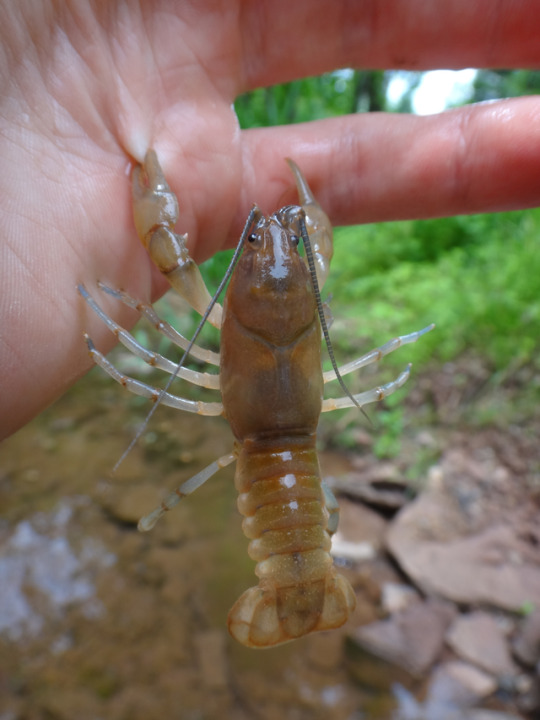
A day in the life of a field biologist
25 notes
·
View notes
Text
Doença Urina Preta

O Ministério da Agricultura, Pecuária e Abastecimento (Mapa) divulgou uma nota na qual alerta sobre uma possível relação entre os casos de doença de Half, conhecida como “urina preta”, observados este ano no Brasil, e o consumo de peixes, mariscos e crustáceos sem o selo dos órgãos de inspeção oficiais.


De acordo com a pasta, todos os casos notificados e em investigação estão sendo acompanhados por epidemiologistas do Ministério da Saúde, em cooperação com os Laboratórios Federais de Defesa Agropecuária (LFDA) e o Instituto Federal de Santa Catarina (IFSC).
A doença de Haff apresenta como sintomas rigidez muscular frequentemente associada ao aparecimento de urina escura, que resulta de insuficiência renal. Ela se constitui em um tipo de rabdomiólise, nome dado para designar uma síndrome que gera a destruição de fibras musculares esqueléticas e libera elementos de dentro das fibras - como eletrólitos, mioglobinas e proteínas - no sangue.
A nota do Mapa informa que os primeiros sinais e sintomas podem se manifestar nas 24 horas após o consumo de peixe cozido, lagostim e outros frutos do mar contaminados.
“A enfermidade é considerada emergente e, por ter origem desconhecida, enquadra-se como evento de saúde pública (ESP), sendo considerada de notificação compulsória”, diz a nota.
Ainda segundo o ministério, os primeiros casos de doença de Half registrados no Brasil foram em 2008, com origem em espécies de água doce como o Pacu (Mylossoma spp), tambaqui (Colossoma macropomum) e pirapitinga (Piaractus brachypomus), bem como em peixes de água salgada, como a arabaiana/olho-de-boi (Seriola spp) e badejo (Mycteroperca spp).
Foram também registrados casos em 2016 e, agora, em 2021. Diante da situação, o Mapa está orientando a população a ficar atenta na hora de comprar pescados, de forma geral.
“Peixes, mariscos e crustáceos comercializados devem conter o selo dos órgãos de inspeção oficiais”, alerta o ministério, ao informar que produtos identificados pelo carimbo de inspeção na rotulagem possibilitam a rastreabilidade de sua origem, o que os torna seguros.
A dificuldade para a identificação do material contaminado está no fato de que a toxina causadora não tem gosto nem cheiro específicos, o que torna mais complexa a sua percepção. Nos relatos registrados ao longo dos anos, pessoas acometidas da doença ingeriram diferentes tipos de peixe, como salmão, pacu-manteiga, pirapitinga, tambaqui, e de diversas famílias como Cambaridae e Parastacidae.
“Pesquisas sobre os possíveis agentes causadores estão sendo realizadas pelo LFDA e o IFSC, a partir das amostras coletadas dos alimentos consumidos, bem como de material biológico dos próprios pacientes acometidos. Por ter sido registrada em diversos biomas (rios, lagos, mares etc) e espécies, não é possível, até o momento, determinar, com base nos casos analisados, os ambientes e animais envolvidos”, informa a nota.
De acordo com o Mapa, foram feitas pesquisas de amostras na busca por “moléculas suspeitas”, especialmente de grupos onde é mais provável encontrar toxinas causadoras da doença de Haff. No caso, “moléculas análogas que podem ser produzidas por microalgas tóxicas”.
Fonte: opovo | Veja também: "Dória pressiona Anvisa por mais vacinas".
Read the full article
0 notes
Text
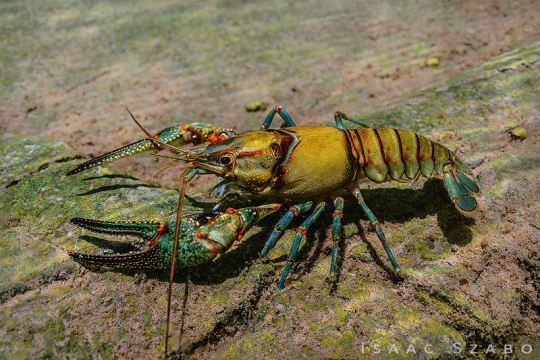
Longpincered Crayfish (Faxonius longidigitus), family Cambaridae, found in the White River basin of southern Missouri and northern Arkansas, USA
photograph by Isaac Szabo
598 notes
·
View notes
Note
Were you more of a crayfish catcher or a cicada catcher kinda kid??
cicada catcher of course.
The crayfish species native to Japan is currently under threat from poor water quality. It’s a rough time for the Cambaridae family
So catch some cicadas instead
2 notes
·
View notes
Text
💙Blue Crayfish🐟
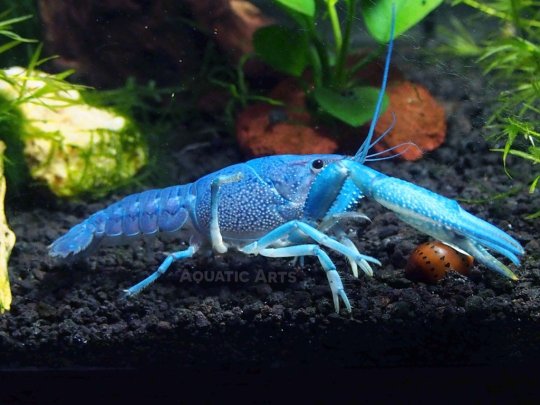
The Blue Crayfish is very popular in the aquarium trade and hobby.
This is the Blue Crayfish, known by its scientific name of Procambarus Alleni. They’re in the Animalia kingdom, Arthropoda phylum, Malacostraca class, Decapoda order, Cambaridae family, Procambarus genus, and P. alleni species. They are well known for their brilliant blue color, though in the wild they also tend to be brown or red as well.
These are freshwater crayfish found mostly in the peninsulas and small bodies of water of Florida and prefer to stay hidden and cozy under anything they can find during the day.
They enjoy feeding on mosquito larvae and occasionally worms. Some have even been known to eat each other!!!

They breed without any specific reason at any time in the year. Females hold the eggs in the area under her tail and will give birth to about 200 of these little dudes each year. They simply hatch like small versions of themselves and will eventually grow to their adult size.
Blue Crayfish have evolved to live in freshwater unlike other similar creatures in saltwater. Their evolution goes back so far, ancient fossils of similar crayfish they evolved from have been discovered.

0 notes
Photo

Crayfish (Cambaridae sp.)
8 notes
·
View notes
Text

Lavender Burrowing Crayfish (Creaserinus byersi), family Cambaridae, Northern Florida, USA
Photograph by Dick Bartlett
453 notes
·
View notes
Note
Do you know what the proper size tank to house a crawfish in is? And a proper diet? Long story short, my parents found one that is lobster size in the middle of the road a really long way away from a water source and decided to keep him (I'm assuming it's a him).
Aquatic pets aren’t something I have a lot of experience with, I suggest going to scalestails. I’ll try my best to answer, but take this with a grain of salt.
First, do you have an ID on the species? Is it legal to keep where you live? Are there any rehabbers nearby that are qualified to care for marine life, which you could take him to instead?
This care sheet suggests 10gal per 6” - 7” crayfish, but Badman says a 10 - 15gal tank is good for a single craw. Seymour Fish says that a 5gal tank is the minimum. Aquariadise lists an 8gal tank as necessary for a dwarf crawfish, so I wouldn’t go any lower than that.
The general consensus seems to be 10 gallons, though.
-Ry
#pets#pet care#crawdads#astacidae#cambaridae#freshwater lobsters#mudbugs#aquatic invertebrates#aquatic invert care#anonymous#asks#crayfish#crawfish
5 notes
·
View notes